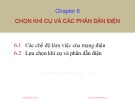
8/19/2014
1
Chương 7
ỔN ĐỊNH TRONG HỆ THỐNG
ĐIỆN
CHỨC NĂNG CÁC HỆ THỐNG
TRUYỀN TẢI VÀ PHÂN PHỐI
ĐIỆN NĂNG
Võ Ngọc Điều
Bộ môn Hệ Thống Điện
Email: vndieu@gmail.com
2
Introduction
- At present the demand for electricity is rising phenomenally.
- This persistent demand is leading to operation of the power
system at its limit.
- On top of this the need for reliable, stable and quality power is
also on the rise due to electric power sensitive industries like
information technology, communication, electronics etc.
- In this scenario, meeting the electric power demand is not the
only criteria but also it is the responsibility of the power system
engineers to provide a stable and quality power to the
consumers.
- These issues highlight the necessity of understanding the
power system stability

8/19/2014
2
3
Basic Concepts and Definitions of Power System Stability
Power system stability is the ability of an electric power
system, for a given initial operating condition, to regain a state
of operating equilibrium after being subjected to a physical
disturbance, with most of the system variables bounded so that
practically the entire system remains intact.
- The disturbances mentioned in the definition could be faults,
load changes, generator outages, line outages, voltage collapse
or some combination of these.
- Power system stability can be broadly classified into rotor
angle, voltage and frequency stability. Each of these three
stabilities can be further classified into large disturbance or
small disturbance, short term or long term.
4
Classification of power system stability

8/19/2014
3
5
Rotor angle stability
It is the ability of the system to remain in synchronism when
subjected to a disturbance.
The rotor angle of a generator depends on the balance between
the electromagnetic torque due to the generator electrical power
output and mechanical torque due to the input mechanical
power through a prime mover.
Remaining in synchronism means that all the generators
electromagnetic torque is exactly balanced by the mechanical
torque.
6
Rotor angle stability
If in some generator the balance between electromagnetic and
mechanical torque is disturbed, due to disturbances in the
system, then this will lead to oscillations in the rotor angle.
Rotor angle stability is further classified into small disturbance
angle stability and large disturbance angle stability.

8/19/2014
4
7
Small-disturbance or small-signal angle stability
It is the ability of the system to remain in synchronism when
subjected to small disturbances.
If a disturbance is small enough so that the nonlinear power
system can be approximated as a linear system, then the study
of rotor angle stability of that particular system is called as
small-disturbance angle stability analysis.
Small disturbances can be small load changes like switching on
or off of small loads, line tripping, small generators tripping etc.
Due to small disturbances there can be two types of instability:
non-oscillatory instability and oscillatory instability.
8
Small-disturbance or small-signal angle stability
In non-oscillatory instability the rotor angle of a generator
keeps on increasing due to a small disturbance and in case of
oscillatory instability the rotor angle oscillates with increasing
magnitude.

8/19/2014
5
9
Large-disturbance or transient angle stability
It is the ability of the system to remain in synchronism when
subjected to large disturbances.
Large disturbances can be faults, switching on or off of large
loads, large generators tripping etc.
When a power system is subjected to large disturbances they
will lead to large excursions of generator rotor angles.
Since there are large rotor angle changes the power system
cannot be approximated by a linear representation like in the
case of small-disturbance stability.
10
Large-disturbance or transient angle stability
The time domain of interest in case of large-disturbance as well
as small-disturbance angle stability is any where between 0.1-
10 s.
Due to this reason small and large-disturbance angle stability
are considered to be short term phenomenon.
It has to be noted here that though in some literature “dynamic
stability” is used in place of transient stability, only transient
stability has to be used.












![Trắc nghiệm Mạch điện: Tổng hợp câu hỏi và bài tập [năm hiện tại]](https://cdn.tailieu.vn/images/document/thumbnail/2025/20251118/trungkiendt9/135x160/61371763448593.jpg)













